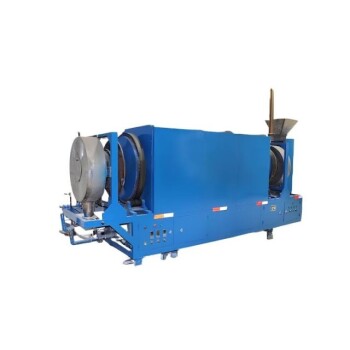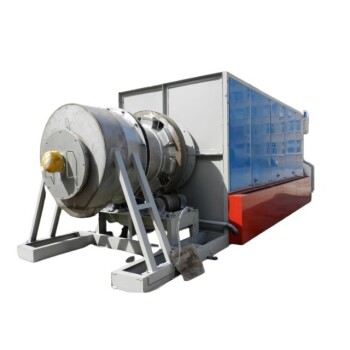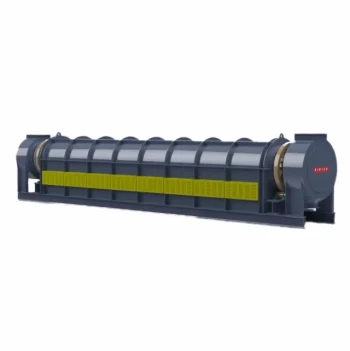Based on direct energy analysis, a rotary kiln's first law thermal efficiency is often cited at around 49%. This figure represents the portion of heat energy from the fuel that is successfully absorbed by the material being processed. The remaining 51% is lost to the environment through the kiln shell, exhaust gases, and other inefficiencies.
A rotary kiln's efficiency is not a fixed value but a dynamic outcome. It is determined by the precise balance between its structural design—which aims to contain heat—and its operational parameters, which control how that heat is transferred to the material.
The Principles of Heat Transfer in a Rotary Kiln
A rotary kiln is fundamentally a heat exchanger designed for continuous material processing. Understanding how it manages energy is key to understanding its efficiency.
The Core Operating Principle
A rotary kiln is a large, rotating cylindrical drum with a slight downward inclination, typically between 1% and 4%. This slope uses gravity to move material from the feed end to the discharge end as the kiln rotates.
The slow rotation, usually between 0.2 and 5 rpm, tumbles the material. This mixing action ensures that the entire batch is uniformly exposed to the heat source, promoting a consistent and homogenous final product.
The Importance of Counter-Current Flow
For maximum thermal efficiency, most kilns employ a counter-current flow system. The material moves down the slope while the hot combustion gases from the burner, located at the discharge end, flow up towards the feed end.
This design is highly efficient. The hottest gases encounter the most processed material, while the cooler gases encounter the fresh, cold feed, preheating it before it reaches the main combustion zone. This maximizes the temperature difference along the entire length of the kiln, ensuring heat is continuously and effectively transferred.
Managing Material Residence Time
Residence time—the duration the material spends inside the kiln—is a critical parameter. It is directly controlled by the kiln's rotation speed and its angle of inclination.
Achieving the correct residence time is a balancing act. The material must remain in the kiln long enough to absorb sufficient heat for the desired chemical reaction or physical change to occur.
Key Factors That Dictate Efficiency
The 49% efficiency figure is a benchmark, but the actual performance of any given kiln depends on a combination of design choices and operational tuning.
Structural Design: Containing the Heat
The kiln's physical construction is the first line of defense against heat loss. Two components are paramount:
- Refractories: The steel shell of the kiln is protected by an internal lining of refractory bricks. This lining serves as a critical layer of insulation, minimizing the amount of heat that radiates away from the kiln shell.
- Seals: Effective seals at the feed and discharge ends are essential for preventing cold air from entering the kiln and hot gases from escaping. Poor sealing is a major source of thermal inefficiency.
Operational Parameters: Fine-Tuning Performance
Once the kiln is built, efficiency is managed through precise operational control.
- Rotation Speed: Too high a speed reduces residence time, meaning the material may exit before being fully processed. Too low a speed can cause material to build up, leading to inefficient heat transfer and inconsistent quality.
- Burner and Combustion: The burner system must be optimized to ensure complete combustion and direct the heat effectively. An efficient flame shape and position are crucial for transferring energy to the material bed rather than the refractory walls.
Process Zoning: A Staged Approach
An efficient kiln process is not monolithic. It is divided into distinct zones, each with a specific thermal purpose.
These zones typically include a drying zone, preheating zone, calcining zone (where the main reaction occurs at peak temperature), and a cooling zone. This staged approach ensures energy is used appropriately at each step of the process.
Understanding the Trade-offs
Optimizing a rotary kiln is not about maximizing a single variable but about balancing competing factors.
Throughput vs. Residence Time
There is an inherent conflict between the speed of production (throughput) and the effectiveness of the heat treatment. Increasing rotation speed to process more material will inevitably reduce the residence time. This can compromise product quality if the material doesn't have enough time to reach the target temperature.
Thermal Efficiency vs. Mechanical Stress
Features that boost efficiency, like thick refractories and complex air seals, also add weight and mechanical complexity. Seals are particularly challenging as they must operate in a high-temperature, abrasive environment, making them a frequent point of failure and maintenance.
Process Control vs. Capital Cost
A highly efficient kiln with advanced sensors, zoned heating control, and a variable-speed drive is more effective but also more expensive to build and maintain. The ideal level of control depends on the value of the final product and the cost of energy.
Making the Right Choice for Your Goal
Understanding these principles allows you to focus your efforts on the parameters that matter most for your specific objective.
- If your primary focus is maximizing energy efficiency: Prioritize the integrity of your refractories and seals, and ensure the kiln operates with an optimized counter-current airflow.
- If your primary focus is achieving maximum throughput: Concentrate on finding the highest rotation speed that still allows for the required residence time and complete product conversion.
- If your primary focus is ensuring product quality: Emphasize stable operational parameters, including a consistent rotation speed and a tightly controlled temperature profile across all zones.
Ultimately, mastering a rotary kiln comes from understanding it not as a single furnace, but as an integrated system where every component influences the final outcome.
Summary Table:
| Factor | Impact on Efficiency | Key Consideration |
|---|---|---|
| Counter-Current Flow | High | Maximizes heat transfer by preheating material with exhaust gases. |
| Refractory Lining | High | Critical insulation layer to minimize shell heat loss. |
| Seal Integrity | High | Prevents air infiltration and hot gas escape, a major source of loss. |
| Rotation Speed | Medium | Balances residence time (for quality) with throughput. |
| Burner & Combustion | Medium | Optimizes flame shape and position for effective energy transfer. |
Ready to Optimize Your Rotary Kiln Performance?
Leveraging exceptional R&D and in-house manufacturing, KINTEK provides diverse industries with advanced thermal processing solutions. Our expertise in high-temperature furnace design, including Rotary Furnaces, is complemented by strong deep customization capability to precisely meet your unique process requirements—whether your goal is maximizing energy efficiency, achieving higher throughput, or ensuring superior product quality.
Let's discuss how we can enhance your operation. Contact our experts today for a tailored solution!
Visual Guide

Related Products
- Electric Rotary Kiln Continuous Working Small Rotary Furnace Kiln for Pyrolysis Plant Heating
- Split Multi Heating Zone Rotary Tube Furnace Rotating Tube Furnace
- Electric Rotary Kiln Small Rotary Furnace Biomass Pyrolysis Plant Rotating Furnace
- Electric Rotary Kiln Small Rotary Furnace for Activated Carbon Regeneration
- Electric Rotary Kiln Pyrolysis Furnace Plant Machine Small Rotary Kiln Calciner
People Also Ask
- How does a rotary kiln function mechanically? Master Material Processing with Precision Engineering
- What is an electric heating rotary kiln and what industries use it? Discover Precision Heating for High-Purity Materials
- How does automated control in electric rotary kilns benefit industrial processes? Achieve Unmatched Precision & Efficiency
- What is the basic working principle of a rotary kiln? Master Industrial Thermal Processing Efficiency
- What are the uses of rotary kilns in the building materials industry besides cement clinker? Key Applications Explained



















